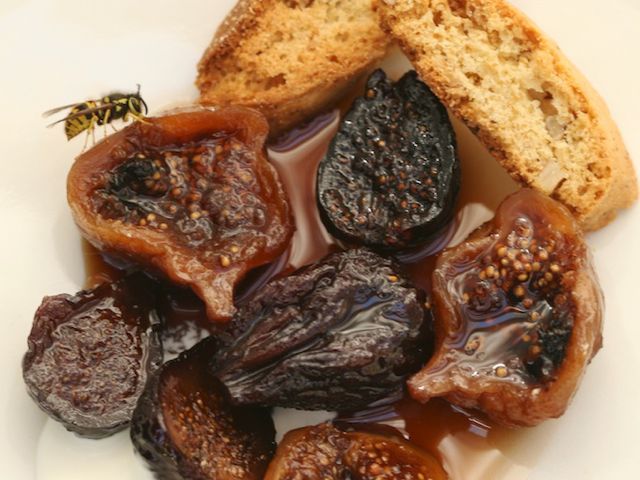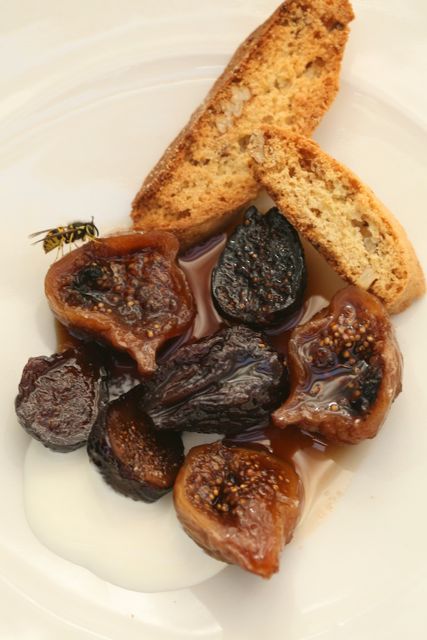
reference-image, l
(article, Deborah Madison)
p(blue).Editor's note: Ever wonder what a photo shoot for a cookbook might be like? Deborah Madison, author of countless cookbooks, knows well. Recently she worked on photos for a new book, tentatively titled Deborah Madison's Desserts, from Farm, Orchard, and Garden. Watch for it in fall 2009. [%pageBreakSettings nobreak=true] I bought a fortune's worth of sugar and flour, every fresh and dried fruit that was called for, wine for poaching, blocks of butter, cartons of cream, chunks of chocolate, and savory foods, too, knowing that I’d be making lunch for my photographer, Laurie Smith, and her assistant, Annie Slokum. The next four days would be devoted to that endurance trial called the photo shoot, the second one for a book I’ve been writing on fruit desserts. [[block(sidebar). h1.Featured recipe]] A couple of months earlier, we had covered the stone fruits, melons, and berries. Now, in the last week of October, we would be pointing the camera at pears, quince, citrus, persimmons, nuts, and dried fruits. There is always some luck involved in a photo shoot. Most importantly, I was able to get the fruits I needed, even though it was still early for some. Second, Daylight Saving Time wouldn't be ending for another week, so we didn’t have to jump through hoops baking and filming extra early. Finally, the wind didn’t blow, a blessing because Laurie ended up shooting everything outdoors in a makeshift studio under the ramada. [%image figs width=300 float=right caption="A fig visitor."] So that we’d be ready to go, I spent the day before Laurie and Annie arrived making tarts, draining yogurt, poaching fruits, and making chocolate barks, cakes, and seven kinds of cookies. I also gathered the dishes we’d be using and checked to see what had been photographed already so that we’d have images throughout the book rather than all clumped together. Laurie and I knew that we didn’t want a lot of props. No napkins, no flowers, and only a few serving pieces. We were also limiting ourselves to white dishes made for the book by the potter Sandy Simon, with a few blue dishes for contrast. Simple, subtle forms, no designs, maybe some linen or a board to set things on, and that would be it. In the 1980s, virtually every food photo had a ribbon winding through it, along with flowers and candles. Crumbs never showed. Stylists replaced whipped cream with shaving cream, burned false grill marks onto food, and used other tricks to make everything natural look artificial. Today it’s the crumbs and flaws that are right up front, even cherished, in food photos. Laurie and I have been working together for 12 years. Annie, who joined us three books ago, is the cheerful, calm, capable person who anticipates all needs and makes the rough patches smooth. We three work well together, but a photo shoot is always grueling, and adjustments are called for. Sometimes I have to rewrite a recipe because I left something out of the photo, like the sweet and salty pecans on the butterscotch pudding. Or maybe I decided to put something in that wasn’t there before, like the passionfruit on caramelized bananas, or a few dried rose petals in the white chocolate bark. When I added a sliver of orange to a strawberry-red wine compote to made the picture come alive, I had to go back and suggest the orange as a garnish. At other times, images suggest themselves that weren’t scripted. Laurie looks into a pot of simmering plums and takes a picture. She sees me using the food mill and snaps another. Her eye travels to a piece of fruit that’s exceptionally beautiful, and she snaps again. Her eye and spontaneity are a gift. Not every photographer would do this. During this shoot, we had some trouble with yellow jackets. As the temperature warmed, hoards of them started visiting Laurie and the dried-fruit compote she was photographing. “Should I swat them?” she asked. They clearly made her nervous. “No!” Annie told her. “Swatting will only stir them up.” So after attempting to negotiate with the yellow jackets, we put some of the fruit in a dish and set it closer to their colony. Sure enough, they found it and left Laurie in peace. The bee was different, though. We were shooting dried figs poached in Pedro Ximinez, a delicious, aged sherry, and a bee was determined to have a little cocktail. He hovered around the figs, lighting on one, then another. We couldn’t get him to leave, so Laurie shot anyway. Personally, I love the bee, but will that be acceptable to the publisher? Maybe not, so we tried again, distracting our friend as best we could. Laurie did get a bee-free image. Invariably, some things go wrong. I wanted to shoot a Swedish Cream, and to be on the safe side, I used a little extra gelatin to make sure it would set well. I must have been tired and didn’t stir it enough; I had also made three cakes that evening, after an all-day shoot. When I unmolded the cream the next day, it had a clear layer of gelatin on top. Pretty, but clearly wrong. Since we needed a picture for that chapter, I thought maybe I could hold two of the dariole molds in my hand and some dessert plates in the other, as if I were going to unmold the desserts. It’s a little far-fetched, but it at least shows the dariole molds, which, I’ve been told, are possibly too obscure to include in the book. The jury is still out on this one. Trying to catch the last of the light, I threw together a yeasted pear upside-down cake in such a hurry that it didn’t rise properly. It ended up in a background shot, out of focus. But then I had to do it all over again, this time allowing time for the rise. Another cake came out lopsided, but a few matchbooks slid beneath restored its balance. I always make beautiful custards with slick, even surfaces, but this time they came out oddly wrinkled on top. Why? I have no idea. Even the second time I made them, they weren’t as perfect as I’d like. This is when you’re glad that sharp focus isn’t valued as much as it used to be. The big question is, what becomes of all these desserts? We do nibble as we work, or have a dessert at lunch or dinner, but that doesn’t make a dent in the 30-plus dishes that appeared over three days. There finally comes a point when we can’t eat another bite. Those that are keepers — the fruit compotes, cookies, or a sturdy tart — get put away. But when it comes to custards and creams, it’s hard to give them away, as portions have been removed, bites taken. A dessert party sounds like a great idea, but by the end of the shoot, the house has been turned upside down, props and equipment are lying around everywhere, and we are all completely exhausted. So I give away what I can to neighbors who I know won’t mind the missing slice or spoonful, and the rest goes right into compost heap — expensive and labor-intensive additions, to be sure. p(bio). Deborah Madison is the author of numerous award-winning cookbooks, including Local Flavors. She lives in New Mexico.

reference-image, l

figs, l